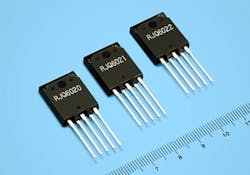Army research eyes next-generation SiC military high-voltage switching devices
RESEARCH TRIANGLE PARK, N.C., 29 Jan. 2013. U.S. Army researchers are asking for industry's help in pushing the state of the art in silicon carbide (SiC) semiconductor power electronics technology for next-generation high-voltage switching devices for military and commercial applications.
The Army released a solicitation Monday (W911NF-13-R-0002) for the Silicon Carbide High-Voltage Power Technology (SiC HVPT) program, which focuses on SiC semiconductor switch design, epitaxial material growth, semiconductor device fabrication, and multi-die packaging for high-voltage applications.
Army researchers are interested in industry ideas for increased current density at high-efficiency, larger die sizes, higher switching frequencies, and blocking voltage greater than 10 kilovolts for low- and high-duty-cycle switches.
Sponsoring the (SiC HVPT) program are researchers at the Army Contracting Command Aberdeen Proving Ground Research Triangle Park activity in Research Triangle Park, N.C., on behalf of the Army Research Laboratory.
SiC is an emerging power semiconductor material that has electrical, thermal, and mechanical properties that allow it to surpass the performance of conventional silicon (Si) power technology, Army researchers say.
The program focuses on SiC HV bi-polar, semiconductor switches with ultimate single die blocking voltages in the range of 15,000 to 24,000 volts and current capacity of 10 amps. These switches should be able to turn off at the maximum conduction current rating.
The Army is considering high-voltage switches for applications that require switches to operate in a totem-pole configuration at plus 15,000 volts and minus 10,000 volts at a peak of 30 amps and a frequency of 35 kHz.
Another application under consideration requires power switches and diodes to control the discharge of 20-kilovolt storage capacitors in a Marx-type power supply with 10-amp average current and 100-amp short-circuit currents.
Army researchers want to develop packaging that provides for voltage isolation, heat transfer, current, and frequency such that the SiC device performance is not limited by the packaging approach and minimize total volume.
Companies interested should respond by 28 Feb. 2013. For questions or concerns contact the Army's Kathryn McManus by e-mail at [email protected].
More information is online at https://www.fbo.gov/notices/a8451e9ffdade389f76fde88f5531780.

John Keller | Editor
John Keller is editor-in-chief of Military & Aerospace Electronics magazine, which provides extensive coverage and analysis of enabling electronic and optoelectronic technologies in military, space, and commercial aviation applications. A member of the Military & Aerospace Electronics staff since the magazine's founding in 1989, Mr. Keller took over as chief editor in 1995.



